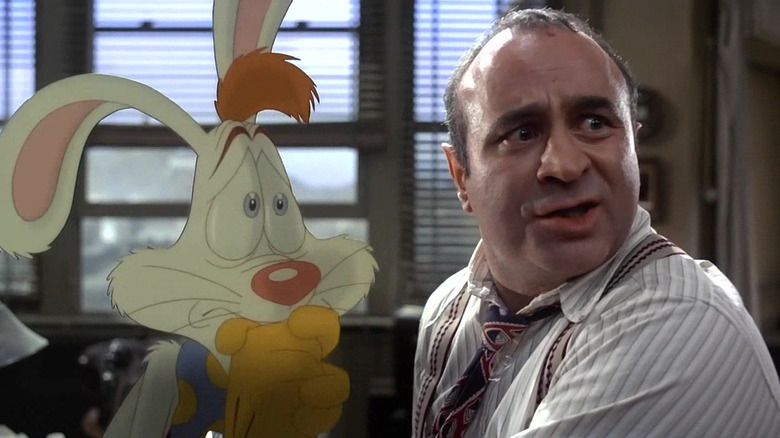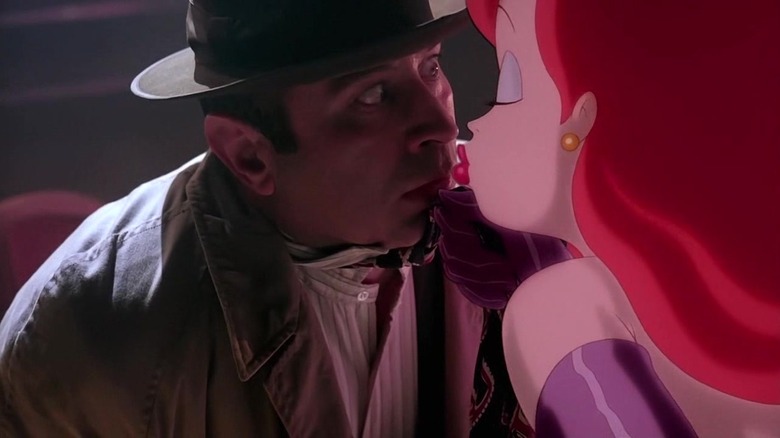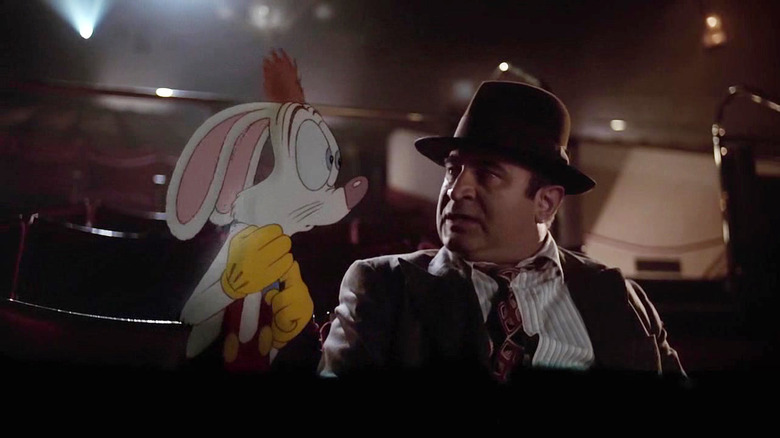Who Framed Roger Rabbit Took An Extreme Mental Toll On Bob Hoskins
It's become very easy to take for granted the experience of watching live actors interact with CGI creations (or really anything that isn't physically on the set of a movie or series). Even the most basic TV shows utilize green-screen now to make it look like real people are standing outside instead of in the middle of a film studio's vast warehouse. But it wasn't always like this, and it wasn't that long ago that actors having to act against the unreal was new and strange, both for audiences and the performers themselves. Though special effects had been part of filmmaking for a long time, one of the most seminal and influential films of this nature was the 1988 fantasy comedy "Who Framed Roger Rabbit."
"Who Framed Roger Rabbit" is one of the great modern films, and not just because it set a new standard for what audiences could expect when human actors interacted with animated creations. The very concept of the film, set in an alternate version of late-1940s Hollywood wherein animated characters like Mickey Mouse and Bugs Bunny exist as actual, living, breathing things outside of the short films they made for Disney and Warner Bros. and the like, meant that humans would have to act opposite characters that wouldn't be fully integrated until the post-production period. Naturally, the burden fell heaviest on the film's leading man: Bob Hoskins as the tough-as-nails private detective Eddie Valiant. And while Hoskins wound up giving one of the most brilliant performances ever captured on screen, it took a heavy toll on him. In fact, he later admitted he essentially lost touch with reality during and after the film's shoot.
Hoskins trained himself to hallucinate the film's cartoon characters
Hoskins was far from the first actor to star opposite someone who wasn't actually on screen with them. In truth, humans and cartoon characters have co-existed in films going as far back as the 1945 musical "Anchors Aweigh," in which Gene Kelly performs a dance sequence with Jerry the mouse from "Tom and Jerry." Still, the level of work Hoskins had to do to constantly interact with the unreal was clearly a massive challenge.
A 2012 article by Express quotes Hoskins as saying, "I had trained myself to hallucinate, and in the end, it screwed up my brain." He also admitted that after filming had wrapped, he would "be sitting, talking normally and suddenly a weasel would creep out of the wall at me." He noted that while his doctors encouraged him to take a bit of time off to decompress from the stress of being in such a big, odd movie, Hoskins went a bit further than their recommendation of a five-month sabbatical, taking a full year off after "Who Framed Roger Rabbit" became a massive success upon its release in the summer of 1988. Ultimately, the actor didn't appear in another film until early 1990, when he co-starred with a young Denzel Washington in the not-terribly well-received crime-comedy/fantasy "Heart Condition." His film output ramped up pretty quickly in the 1990s, though, as he appeared in everything from Steven Spielberg's "Hook" to the live-action "Super Mario Bros." movie.
In hindsight, of course, Hoskins' reaction may seem extreme, but it also makes perfect sense. Even now, when working with CGI creations is plenty common for actors in franchises like "Star Wars" and the Marvel Cinematic Universe, that doesn't make it any less normal. Still, today's actors can at least take heart in the knowledge that they're far from alone in experiencing this, whereas Hoskins no doubt felt like a true standout in his own way, and not a good one. Even his co-star Charles Fleischer (who voiced both the eponymous cartoon character and the streetwise Benny the Cab) seemed a bit off. In making-of featurettes about the film, Hoskins and others recalled Fleischer dressing up as Roger Rabbit to appear on set as a reference point. That may have been helpful to an extent, but it was also no doubt quite odd for all involved.
Hoskins' Roger Rabbit performance is one of the great acting turns in modern film history
What would modern blockbuster cinema look like if it wasn't for the immense popularity of the now-classic "Who Framed Roger Rabbit"? The Robert Zemeckis movie proved that the impossible was doable; that you could put real actors next to animated creations, and it would not only look believable, but it could also be a mammoth piece of cinematic entertainment. Zemeckis, for his part, became known for trying to push the technological envelope after that, particularly with his motion-capture animated films and projects like with his abandoned CGI Beatles movie (though it's likely for the best that one never happened).
Notably, people like to perceive the summertime success of Tim Burton's "Batman" in 1989 as being the fundamental thing that shifted how modern cinema became perhaps nothing more than a combination of intellectual properties being utilized by major film studios to make big bucks. In truth, though, the balance between art and commerce in summer cinema hit an apex the year before with the unique and distinctive "Who Framed Roger Rabbit". And just as the many, many talented behind-the-scenes craftspeople who worked to create the movie's various animated characters deserve a heap of credit, so, too, does the late Hoskins for his own contributions.
Hoskins may not have been able to appreciate the impact of his work on this film, and understandably so. The mental toll that "Who Framed Roger Rabbit" took on him is understandable and somewhat tragic (as was his passing in 2014 from Parkinson's disease), but the question now is: was it worth it? Is it worth having such an intense filming experience that you hallucinate multi-dimensional animated characters co-existing with you outside of a film set, assuming the film in question is one of the best of all time? For the audience, it may have been worth the struggle, but it's hard not to empathize with Hoskins, especially considering the high quality of his work and the high bar he unknowingly set for so many other actors going forward. If he could put his whole being into this movie, then perhaps other performers ought to be ready to do the same.


